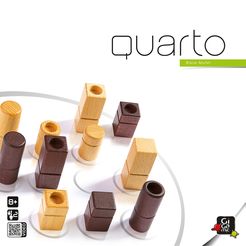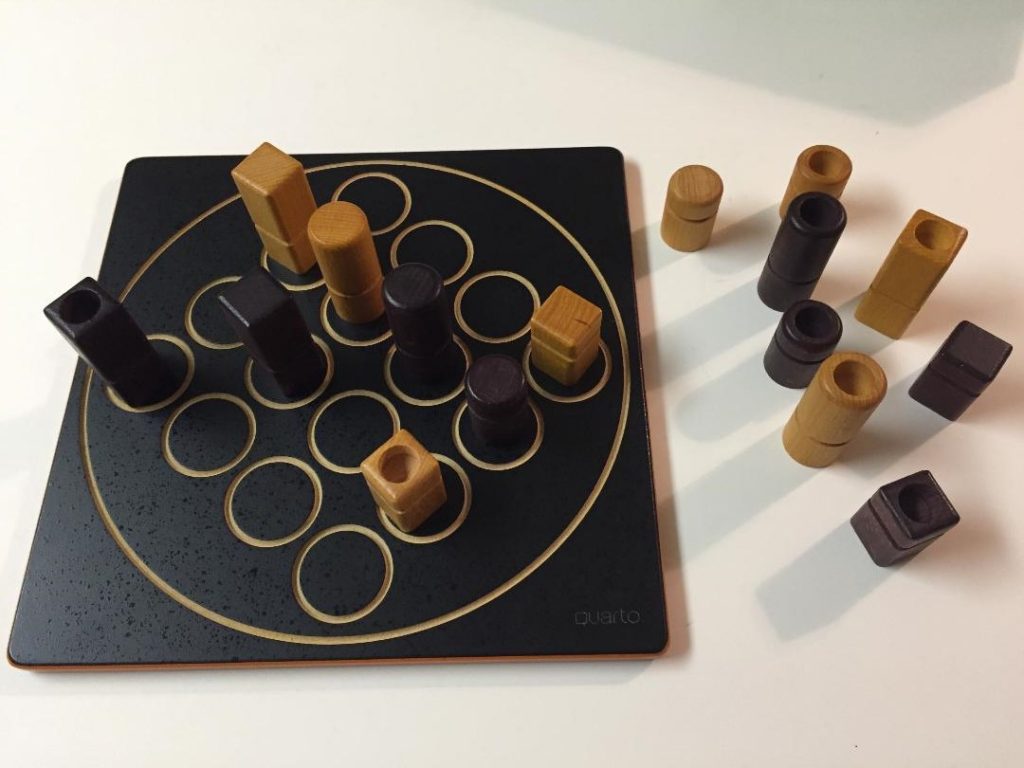
BoardGameGeek categorizes Quarto as an Abstract Strategy game. Some attributes of this type of game include simple design / mechanics, no obvious theme, little or no luck element, and a lack of theme. If you have played tic-tac-toe then you have played an abstract strategy game. 🙂 In tic-tac-toe games between equally skilled players will almost certainly end in a draw. Perfect play ends up with no winner every single time. There is no hidden information, no element of luck, and no theme or story-line. It’s a classic that every child learns growing up.
Quarto is—dare I say it?—similar to tic-tac-toe in that it falls into the “N In A Row” sub-category of abstract games. The goal is to get four tokens in a row that share a common attribute. The four attributes are height (tall or short), color (light or dark), shape (round or square) and density (hollow or solid). If any one attribute appears on four tokens in a row, the person who identifies the row wins!
With the simplicity of tic-tac-toe it’s easy to learn all of the traps and blocks, resulting in a tie game almost all of the time. As two people become more familiar with Quarto, does it also progress into mostly tie games?

I spent part of last year playing Quarto with someone at work. His desk was next to mine, so we placed the board on the partition between our two desks. (It’s not as precarious as it sounds.) Over the course of several months we played 17 games. Yes, only 17. There were several games that finished on the same day they started. The longest took 26 days to complete because of work and vacations. I kept a very detailed log of the games. I don’t know if 17 games is enough to draw any conclusions, but I’ll try.
In 17 games, we had 3 draws. If the hypothesis is true, we would expect the draws to be more common in the later games rather than earlier. (We both had roughly equal experience going in.) Our first draw was in game 11 and the others were game 13 and 15. Games 1-10 all had a definitive winner. In games 11-17 three games were draws. As we gained experience in the game, draws became more frequent. That would tend to support the hypothesis.
With 3 draws out of 17 games that meant we had 14 games with a winner. What else can we observe?
First Player
The first player won 7 and lost 7, so that was exactly even. There didn’t seem to be a first player advantage.
Winning Pattern
There are 4 ways to win horizontally, 4 ways to win vertically, and only 2 ways to win diagonally. (We did not use the advanced / optional victory rules where four in a corner was also a win.) Would you expect 80% of the games to be horizontal / vertical and 20% diagonal?
Out of 14 winning games, 5 were horizontal and 3 were vertical and 6 were diagonal. Why? Maybe it’s because we tend to focus on the things that are easier to see, and horizontal / vertical felt easier. We get so focused on the horizontal and vertical that the diagonal sometimes sneaks up on you.
Was it because we got better at the game, and diagonal victories became more common? There were two diagonal wins in games 1-6, two diagonal wins in games 7-12, and yes two more diagonal wins in games 13-17. Diagonal victories were equally distributed.
Game Length / Tokens Played
The average number of tokens played was 12.17. That includes the three draws where obviously all 16 tokens are played but we also had one game where the 16th token resulted in a win.
Winning Attributes
The game is won when four tokens in a row share some attribute. In our 14 victories the distribution went like this:
| Attribute | Count |
|---|---|
| Tall | 1 |
| Short | 2 |
| Solid | 1 |
| Hollow | 3 |
| Square | 2 |
| Round | 1 |
| Light | 3 |
| Dark | 1 |
We had one game where there were actually two four-in-a-row placed (Square vertical and Light horizontal) but that was unique. The extra Light/Horizontal result is not reflected in the stats above because I could not figure out how to make my spreadsheet account for the double win, so I just picked the other.
Attribute Frequency
That last section talked about how often an attribute won. What about play count? For us, the least frequently selected / played piece was the Tall Hollow Dark Square piece. It only appeared in 8 of our 17 games, or less than half. The most frequently used piece was Tall Solid Light Round appearing in 15 of 17 games.
Overall Light appeared 3% more than Dark, Round 5% more than Square, and Solid 3% more than Hollow. The closest to even was Tall/Short with Short appearing a scant 1% more than Tall.
Conclusion
There were some interesting statistics observed in our 17 games. No first player advantage, diagonal victories occurring at a higher rate than expected, and as originally presumed, the more we played the more likely it was to experience a draw. When I play people new to the game I typically win (I’m mean that way 😈 ). But when I’m playing someone as good (or better) than I am, games do tend to run longer, and seem more likely to end in a draw. I think the hypothesis is true.